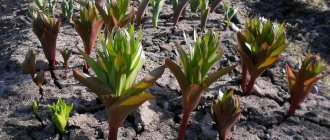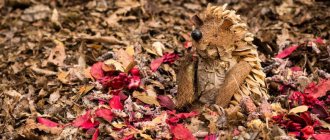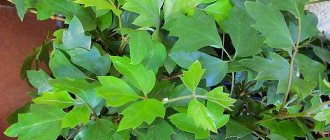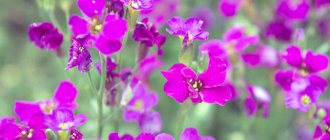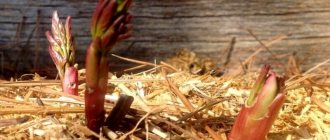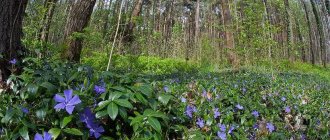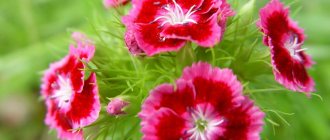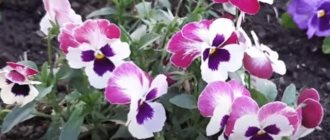In Latin, fritillaria is designated as “hazel grouse”; in common people it is called the “royal crown”. Regardless of the name and variety, fritillaria can be called one of the brightest and most fragrant representatives of the flower world.
A tall and stately plant will be a wonderful addition to the design of a flower bed or garden. The fritillaria flower will not leave any gardener indifferent, and growing the “royal crown” will not be difficult, since hazel grouse is an unpretentious flower and gets along well with its neighbors in the garden.
Fritillaria planting
Proper organization of autumn planting and care of the fritillaria flower, as well as timely control over the plantings, will reward you in the spring with fragrant, lush flowering and a colorful picture of bright hazel grouse buds.
Fritillaria is in demand among most gardeners for its variety of inflorescence color palette and relative unpretentiousness.
Fritillaria is a colorful member of the lily family and has about a hundred varieties of its species. Therefore, choosing the appropriate variety of hazel grouse specifically for your site will not be difficult.
Fritillaria prefers fertile soil, with an average pH level, not clogged, loose and aerated. The planting area should be well lit, but with variable solar activity. In too shaded places, fritillaria will stretch upward, depriving the buds of nutrients, and this will affect the size and color of the inflorescences.
If your area for planting hazel grouse does not meet the above requirements, do not be upset. Poor soil can be easily corrected; to do this, you need to prepare the site in advance. Having dug up the soil at least as deep as a spade, add organic fertilizer 5 buckets for every 5 square meters. m. of land.
Planting of fritillaria begins at the end of August, beginning of September, but not later, since the bulb must take root and have time to gain strength for the upcoming release of the peduncle.
Fritillaria is a large, weighty plant; with a thick, fleshy, tall peduncle, so the planting depth should be at least 25 cm. If the soil of your site is “clogged” or heavy, shallow planting of the bulb up to 25 cm will facilitate germination. But, the optimal solution would be to “lighten” such soil; to do this, add sand (a bucket per 1 sq.m.) and peat (1.5 buckets per sq.m.) into the soil and dig it up.
To correctly calculate the depth of embedding of a fritillaria bulb, you need to multiply the diameter of the bulb by three.
Before planting, fritillaria bulbs are inspected, damaged and suspicious areas are cut off, soaked for several minutes in a solution of potassium permanganate, dried by sprinkling the sections with activated carbon or ash, and then planted.
Holes for planting fritillaria must be formed so that the flowers do not interfere with each other; maintaining a distance of 30 cm between plants will be sufficient. The depth of the hole varies from 25 cm on heavy soils and 35 cm on light soils. A centimeter layer of sand is placed at the bottom of the hole, which will serve as drainage, the soil is abundantly moistened, then the bulb is laid and sprinkled with fertilized soil.
The future flowering and reproduction of the plant will depend on the depth of planting of the fritillaria bulb. The larger the bulb, the deeper the planting. Fritillaria requires a balanced level of soil acidity; the flower will not grow on acidic soils; the same applies to swampy conditions; hazel grouse cannot tolerate stagnant water.
Before planting, think about dispersing the flowers throughout the area; fritillaria blooms all spring and then dies, so it would be better to plant hazel grouse bulbs nearby with other flowers so that the flowerbed does not seem empty.
Planting a flower Imperial fritillary
It is advisable to plant spring flower bulbs in September-October. Remember that the planting depth should be 3 times greater than the height of the bulb itself, so it varies from 10 to 30 cm. Such deep planting allows the hazel grouse to draw water from the lower layers of the soil and survive frosts in winter. If you plant several flowers next to each other, the distance between them should be at least 40 cm.
The bulbs have a round shape with notches on top. This side should be set up. If the bulbs have small roots, use this as a factor in determining which side is the bottom. When planting, experts advise laying the bulbs at an angle on a layer of sand so that water does not stagnate in the upper recess.
After planting, water the planting site well. Roots will begin to form in the fall, and flowers and foliage will form in the spring.
Remember, Fritillaria bulbs dry out quite quickly, so be sure to plant them as soon as you get them home from the nursery or as soon as they arrive in the mail.
Caring for fritillaria flowers
Caring for fritillaria in open ground does not require significant effort and includes basic agrotechnical measures: weeding, hilling, watering, and fertilizing. And due to the botanical distinctive feature of fritillaria, absorbing moisture not only from the soil, but also from the atmosphere (due to the structure of the leaves) minimizes the frequency of watering.
Fritillaria is an unpretentious plant with enormous potential for luxurious flowering. But in order for the “royal crown” to please you with large inflorescences, minimal fertilization is still necessary.
Fertilization is carried out twice, before flowering and after, so that the bulb gains strength and prepares for wintering. Before fritillaria blooms, apply nitrophoska or phosphorus-potassium fertilizers, water, and after a few days add ash.
Loosening is required when the plant is just beginning to emerge, and also if you notice that the soil has become crusty, once every two weeks will be sufficient for fritillaria to develop.
Watering is done once a week, in dry areas and on light soils twice.
After the hazel grouse has bloomed, the peduncle is cut off, and a week later (after drying) the foliage is cut off, the fritillaria is fertilized with phosphorus and potassium and watering is stopped. In harsh winters, the “royal crown” is covered with mulch.
Fritillaria is resistant to diseases and attacks of harmful insects; it even repels some pests with its specific aroma.
Fritillaria propagation occurs both vegetatively and by seeds. Fritillaria seeds are small and ripen in a seed box formed immediately after flowering.
After the walls of the box have dried, the seeds can be collected. However, sowing hazel grouse is a painstaking and difficult task, since such a flower will bloom only four years after the formation of the bulb.
Seeds are sown in the spring, in warm, fertilized soil, so that the seedlings can get stronger by winter, with a sowing depth of 2 cm.
It is better to sow fritillaria indoors or in a greenhouse, wait until the plant gets stronger and forms a bulb, and then, after vernalization, plant the hazel grouse in open ground.
The vegetative method of propagation of fritillaria occurs by division (formation of children) of the mother flower bulb. New “babies” should not be transplanted in the first year; it is necessary to allow the young bulb to learn to live independently and acquire a sufficient number of roots.
The optimal time for transplanting fritillaria is the first ten days of autumn; during this period, separate the two-year-old children from the mother bulb; they are easily detached and there are no problems with transplantation.
Pests and diseases of the imperial hazel grouse
Although the plant is resistant to almost most plant diseases, root rot can be a serious problem for the flower. Avoid overwatering and provide it with well-drained soil to prevent rot problems. Space plants at least 25cm apart to ensure proper air circulation for the bulbs, which will minimize the chance of rot, as well as mildew, rust and leaf spots.
Lily rattle is also often found on leaves. These tiny red beetles begin to appear in the spring around the beginning of April. Pests eat holes in the leaves. They are difficult to control because insecticides cannot kill the beetles without harming the plants.
As an alternative to treatment, you can catch insects manually and install glue traps around the affected plants. If beetles become an annual problem, remove any infested stands.
Fritillaria "Rubra"
The perennial variety of fritillaria "Rubra" has large scarlet inflorescences and emerald green leaves. Height is about 75 cm. It blooms for up to three weeks, profusely and colorfully, after “Rubra” it throws out the seed box and goes into a dormant state. Reproduces vegetatively (by children) and seeds. The "Rubra" variety of fritillaria does not require special care. Suitable for both planting in open ground and for use as a potted crop.
Plant hazel grouse in your garden
We will not be talking about game at all, but about a beautiful perennial flower - hazel grouse. The Latin name fritillaria comes from the word fritillus, which means a chessboard or a vessel in which dice are placed. All these names are associated with the shape and color of the flower. In Russia, the plant got its name for its resemblance to a bird of the grouse family.
Imperial hazel grouse
The flowering of hazel grouse is very short - about 20 days. In most species it begins in the second half of May. The flowers of the hazel grouse are large and hang down like an umbrella, as if they have lowered their heads. They have a specific smell. Moles, shrews, and mice cannot tolerate it. Hazel grouse are a great way to keep these animals away from beds and flower beds.
Fritillaria "Ryabchik"
The variety belongs to the perennial, bulbous variety. It has a strong, tall stem, narrow dark green leaves, large, elongated, drooping flowers.
The inflorescences bloom almost simultaneously, with an interval of a day.
The flowers are bright orange in color and, depending on the variety, are spotted or have large veins. Flowering begins in May and lasts up to three weeks. "Hazel grouse" prefers shaded places and fertile soil. The flower reproduces quickly, without care and planting it quickly runs wild. The most prominent representatives of the variety can be called: Imperial hazel grouse, Kamchatka, Caucasian, Russian, Mars, Orion, Aphrodite.
Reproduction
To propagate the hazel grouse flower, gardeners most often use the vegetative method, that is, the natural division of the bulbs. True, the method is not the most productive, since fritillaria is not particularly prolific. For example, Imperial hazel grouse is capable of producing only two daughter bulbs per season. In addition, young planting material must be grown to standard sizes for several years.
This is interesting. It is because of such a long and difficult process that gardeners often resort to seed reproduction.
Breeding rules:
- Fruit capsules are collected not fully ripe to prevent cracking.
- Seeds are sown immediately after peeling in light, nutritious soil to a depth of 5 cm.
- At the same time, fertilize the flowers.
- The planting site is watered and covered with film.
The first shoots appear next spring. The seedlings are not dug up, but left in the ground to grow for 2–3 years.
The process of propagation by seeds is very long, but produces a lot of planting material.
There is another way of plant reproduction - artificial separation of scales. In this case, a healthy, large onion is broken into several parts, which are immediately planted in the school. By the end of August, the scales take root and go to winter. Buds on such plants appear in the third year.
Fritillaria "Imperial"
Fritillaria “Imperial” has one of the largest inflorescences and buds. It was this variety that was the first to be called the “royal crown”. The inflorescences are collected in a tight, lush crown from bright orange to scarlet; above the inflorescences there is a kind of crown of leaves. An unpretentious variety, blooms from May to June. Reaches up to a meter in height. Will be a wonderful addition to any flower arrangement.
Community of little green men
Fritillaria, Fritillaria, fritillaria (fritillaria). Bulbous plants, from 10 to 100 cm in height. The flowers are bell-shaped, drooping, from 2 to 6 cm in diameter, white, green, red, brown or yellow.
Types and varieties of hazel grouse
The genus includes 179 species of bulbous plants growing in temperate zones of Europe, Asia, and North America. In the conditions of central Russia, two species are most stable in cultivation and widely distributed in ornamental gardening; about 40 more species are found in amateur collections.
Based on the size and shape of the bulbs, the outlines of the stamens, nectaries, the shape and color of flowers and leaves, the methods of attaching leaves to the stems and the origin, all types of fritillaries are divided into 6 sections;
Section I Eufritillaria contains a large number of species (divided into 4 groups) originating from Western Europe, the Mediterranean and Western Asia;
Section II Petilium comprises larger species native to Turkey, Turkmenistan, Northeastern Iraq and Iran and the Western Himalayas;
Section III Theresia includes 1 species - Persian hazel grouse (Fritillaria persica), originating from Western Asia;
Section IV Rhinopetalum contains species from Afghanistan and Western China;
Section V Korolkowia is represented by one species, Severtsov's hazel grouse (Fritillaria severzowii);
Section VI Liliophiza includes species from North America.
Grouse bulbs are not covered with dense protective scales, so they can dry out quickly. Their size largely depends on the species. They usually consist of two fused fleshy scales, between which the exit point of the stem is visible.
Section I Eufritillaria
The most popular species not only of the first group, but also of the entire botanical genus is the checkered hazel grouse (Fritillaria checkerboard).
Checkered hazel grouse, checkerboard fritillaria (Fritillaria meleagris)
Section I Eufritillaria, group A
In cultivation since 1572. The specific name meleagris means “spotted plumage color,” like a hazel grouse or black grouse.
Plant up to 35 cm tall. The leaves are linear-lanceolate, narrow. The flowers are single, less often two, bell-shaped, drooping, brownish-violet with a clear checkerboard pattern, up to 2.5 cm in diameter. Blooms in late spring for 2-3 weeks.
Relatively unpretentious. Prefers semi-shaded places, light fertile soils without stagnant moisture. It can grow in one place for many years without transplanting. Plants are dug up only for propagation in order to plant a nest of bulbs. Under favorable conditions, it quickly spreads on its own and runs wild.
The species has many garden forms and variations.
Popular varieties of hazel grouse:
Checkerboard fritillary 'Aphrodite' - white flowers 20-40 cm high with green markings on both the inner and outer sides;
Checkered hazel grouse 'Artemis' - large purple flowers with green markings, stem height - 30-40 cm, variety known since 1947;
Checkerboard fritillary 'Charon' - dark flowers with barely visible marks, cultivated since 1947, peduncle height - 20-25 cm;
Checkerboard fritillary 'Jupiter' - a garden form, distinguished by especially large flowers, bred in 1947, dark red flowers with a clear checkerboard pattern, plant 20-25 cm high;
Checkerboard fritillary 'Mars' - dark purple flowers are located on stems 20-30 cm high;
Checkered fritillary 'Orion' - this garden form is similar to 'Jupiter', but differs from it in the violet-purple color of the flowers with a light speckled pattern;
Checkerboard fritillary 'Pink Eveline' - flowers are pink, become white or gray over time, peduncle height 40-50 cm;
Checkerboard fritillary 'Poseidon' - white flowers with purple markings;
Checkered fritillary 'Saturnus' - flowers are large, red-violet, covered with light spots, the height of the peduncles is 20-25 cm.
Checkered hazel grouse variety Alba (Alba) is a white-flowered form, known since 1982, forms stems up to 20 cm high, with a green spot located near the nectaries.
Mikhailovsky's hazel grouse, Mikhailovsky's fritillaria (Fritillaria michailowskyi)
Section I Eufritillaria, group C
Homeland - North-Eastern Türkiye. The species was described in 1904 by Mikhailovsky, but became truly popular after it was discovered in Turkey in 1983.
This hazel grouse has low (about 20 cm) stems with red-purple flowers with yellow edges. The inner surface of the perianth is also canary yellow.
Stable species, requires well-permeable soil for normal development.
Mikhailovsky's hazel grouse, Mikhailovsky's fritillaria (Fritillaria michailowskyi)
The most famous - imperial hazel grouse (Fritilaria imperialis) and chess grouse (F. meleagris) are relatively easy to reproduce in culture. Mikhailovsky's hazel grouse (F.michailowskyi), Pontic (F. pontica) and pale-flowered (F. pallidiflora) do not reproduce independently in the garden, but aged bulbs can be easily replaced with fresh ones.
Fritillaria acmopetala, Fritillaria acmopetala
Section I Eufritillaria, group C
Homeland - meadows of Asia Minor and Western Asia, Cyprus, Türkiye, Syria. The species was introduced to Europe in 1874.
Stems 20–30 cm tall. The leaves are linear-lanceolate. The flowers are bell-shaped, usually solitary, and typically contrasting green-brownish or olive green with brown markings. Blooms in May.
Grows well in any soil in light and partial shade. The species is stable in culture. Produces a large number of daughter bulbs.
Caucasian hazel grouse, Caucasian fritillaria (Fritillaria caucasica)
Section I Eufritillaria
Homeland - mountain meadows of the Caucasus and Asia Minor.
The bulbs are 1–1.5 cm in diameter. Stems are 10–25 cm tall with 2–3 bluish leaves and single drooping narrow bell-shaped dark red-brown flowers with a bluish bloom on the outside. Blooms in early May.
For planting, choose open areas with rich soils. Propagated by daughter bulbs and seeds. It blooms 4–5 years after sowing.
Grown mainly in botanical gardens. The species is stable in culture.
Yellow hazel grouse, yellow fritillaria (Fritillaria lutea)
Section I Eufritillaria
Homeland - mountain meadows of the Caucasus and Asia Minor.
Stems are 7–10 cm tall, leaves are green, lanceolate. The flowers are large, 4–5 cm long, yellow with a checkerboard pattern. Specimens with white flowers are known. Blooms in mid-May.
The species grows both in light and in partial shade, on rich, loose soils. Propagated by seeds. Blooms 3–5 years after sowing.
Checkerboard fritillaria, or small fritillaria, checkerboard fritillaria, or small fritillaria (Fritillaria meleagroides)
Section I Eufritillaria
Homeland - meadows, edges of floodplain forests, southern European Russia, Ciscaucasia, Ukraine, Kazakhstan.
The bulbs are 1–1.5 cm in diameter. Stems up to 50 cm tall, with alternately arranged narrow-linear leaves. There are 1–2 flowers on one stem, less often 3. Dark brown flowers with a bluish bloom, bell-shaped, 2–3 cm long. There is a form with white flowers. Blooms in mid-May.
The species prefers illuminated areas with well-drained soils. Reproduces mainly by seeds. Blooms in 3–5 years.
Quite rare in culture. Less stable than checkered hazel grouse.
Mountain grouse, mountain fritillaria (Fritillaria montana)
Section I Eufritillaria, group C
Homeland - the south of France, Italy and the former Yugoslavia, as well as in Northern Greece, Ukraine, Moldova, Romania. Despite the fact that it began to be cultivated back in 1832, it still remains little known.
The bulbs are 2 cm in diameter. From a rosette of grayish-green leaves rise peduncles 15–40 (up to 60) cm high, bearing 1-3 short bell-shaped flowers of green color. On the outside they are so densely covered with black-purple or brown spots that the green tone is visible only from the inside. The earliest flowering species of hazel grouse (early to mid-May).
Plants grow well under the branches of shrubs in any well-permeable soil. In summer it needs increased watering. The species is stable in culture. Gives self-seeding and a large number of children.
Fritillaria pallidiflora, Fritillaria pallidiflora
Section I Eufritillaria, group A
Homeland - alpine and subalpine meadows, Eastern Siberia, Northwestern China, Kazakhstan. Middle Asia.
The species was discovered back in 1887 by E. von Regel, director of the Botanical Garden of St. Petersburg.
Bulbs up to 4 cm in diameter. The stems, 20-80 cm high, are covered with gray-green bluish broadly lanceolate leaves and at the tops bear 5-9 large drooping pale yellow bell-shaped flowers. Blooms at the end of May.
In the first few years after planting, it blooms irregularly. The species likes the soil to remain moist throughout the summer. Grows well in light and partial shade, on any soil without stagnant water. Propagated vegetatively (by daughter bulbs) and by seeds. Blooms 3–5 years after sowing.
One of the most stable hazel grouse in cultivation.
Pyrenean hazel grouse, Pyrenean fritillaria (Fritillaria pyrenaica)
Section I Eufritillaria, group C
Homeland - mountain meadows of the Pyrenees and northwestern Spain.
Stems are 15–30 cm tall. The flowers are elongated bell-shaped, about 2.5 cm long, dark purple outside, yellow (olive green) inside. The tips of the perianth lobes are curved outward. Flowering in May.
Open drained areas with any soil. The species is stable in culture. Occasionally grown in botanical gardens.
Russian hazel grouse, Russian fritillaria (Fritillaria ruthenica)
Section I Eufritillaria
Homeland - floodplain meadows, edges and clearings of deciduous forests, steppes. Middle zone and south of European Russia, Ciscaucasia, south of Western Siberia, Kazakhstan, Ukraine.
Bulbs up to 2 cm in diameter. Stems up to 70 cm tall with linear, partly alternate, partly whorled (lower) leaves. The uppermost leaves have "antennae". The dark flowers are bell-shaped, reddish-brown, 1.5–2.5 cm long, rarely solitary, usually 3–10 pieces, up to 30. Plants with white and double flowers are found in nature. Blooms at the end of May.
The species grows on any soil, in light and shade. It reproduces mainly by seeds and self-sows. It blooms 4-6 years after sowing. The species is stable, but rare in culture.
Thunberg's hazel grouse, Fritillaria thunbergii
Section I Eufritillaria, group B
Homeland: China, Japan. At home, it is grown in large quantities to make cough syrup. It came to Europe in 1830.
The height of the stems is 30-80 cm. Each of them bears up to 6 usually drooping, but sometimes erect white flowers with green veins on the outside and brown markings on the inside of the perianth. During the flowering period, the stems must be provided with supports.
Foxtongue hazel grouse, foxberry hazel grouse, Assyrian hazel grouse, foxberry fritillaria or Assyrian fritillaria (Fritillaria uva-vulpis)
Section I Eufritillaria, group D
Homeland - mountain meadows of Asia Minor, Iran, Iraq, Eastern Türkiye.
The height of the stems is 10-35 cm. The leaves are linear-lanceolate. The flowers are solitary, bell-shaped, no more than 3 cm long, usually greenish-brown in color (dark brown on the outside and olive on the inside). A yellow stripe runs along the edge of the perianth. Blooms in May. Illuminated areas with any soil, prefers moist soil. Rocky gardens with groups of different flowers, contrasting in color, and hazel grouse. Stable. Unpretentious. Gives a large number of children.
Fox tongue hazel grouse, foxberry hazel grouse
It is often grown in botanical gardens. In Europe it is also grown for cutting.
Section II Petilium
Imperial hazel grouse, imperial fritillaria (Fritillaria imperialis)
Section II Petilium
Homeland - Türkiye. The most common species in cultivation, it came to Europe back in 1580. Carolus Clusius (Clusius) planted its first specimens in the HORTUS botanical garden in Leiden. Over the course of just one century, more than 30 variations were developed. Now there are about 20 modern forms of this species.
A plant with large, up to 15 cm in diameter, bulbs that have an unpleasant odor and a hole in the center. The stem is powerful, up to 100 cm in height and above. The stem leaves are broadly lanceolate, collected in whorls. The flowers are bell-shaped, drooping, up to 6 cm in diameter, orange with red-brown veins, with a purple-brown spot at the base, collected 6-12 in a whorl at the top of the stem. Garden forms may take on a different color. Blooms in spring, 11-13 days. After flowering, the above-ground part dies off until next spring.
Prefers warm areas in the partial shade of deciduous trees. Requires loose, nutritious soil and does not tolerate waterlogging. Only completely decomposed humus is used as an organic soil amendment. Plants suffer from soil moisture in the summer, during the dormant period, so it is recommended to dig up the bulbs annually after the stems die and plant them again in flower beds in late September - early October. Plant the bulbs obliquely so that moisture does not enter the central hole. In the spring, during the period of leaf growth, the plants are fed with complete mineral fertilizer. They are propagated by baby bulbs, which are formed with different intensity in different varieties.
Popular varieties of imperial hazel grouse:
The imperial hazel grouse 'Aureomarginata' is a garden form, known since 1665, with orange flowers with a pattern of red veins, located on stems up to 90 cm high. The leaves are edged with yellow stripes. The variety is not winter-hardy;
Imperial hazel grouse 'Aurora' - low-growing form, flowering stems do not exceed 60 cm, orange-red flowers, may suffer from night spring frosts;
Imperial hazel grouse 'Lutea' - the variety has been cultivated since 1665, the height of the stems is 80-100 cm, the flowers are golden-yellow with a network of purple veins;
Imperial hazel grouse 'Maxima Lutea' - a form reminiscent of the variation 'Lutea', only larger, cultivated since 1867, height of peduncles - 120 cm;
Imperial hazel grouse 'Premier' - peduncles 80-100 cm high, orange flowers with light purple veins;
Imperial hazel grouse 'Prolifera' ('Kroon op Kroon' ("Crown on a crown") - orange-red flowers form two tiers, located one above the other;
Imperial hazel grouse 'Rubra' - reddish-orange flowers;
Imperial hazel grouse 'Rubra maxima' - very large, orange flowers, stems 80-100 cm high, cultivated since 1665;
Imperial Fritillary 'Sulferino' - an old variation with orange flowers covered with a network of red-purple veins, 80-100 cm high;
Imperial Fritillary 'William Rex' is an old variation, named after William III, with dark red flowers.
Edward's hazel grouse, Edward's fritillaria (Fritillaria eduardii)
Section II Petilium
The species is identical to the imperial hazel grouse (F. imperialis), with the name "imperial hazel grouse" taking precedence.
Flower growers sometimes call "imperial hazel grouse" - cultivars, and Edward's hazel grouse - specimens from nature.
Radde's hazel grouse, Radde's fritillaria (Fritillaria raddeana, Fritillaria askabadensis)
Section II Petilium
Homeland - meadows of the middle and lower mountain zones of Turkmenistan and Iran.
A yellow-green-flowered garden form of imperial hazel grouse of Dutch origin is sometimes grown under the name Fritillaria raddeana.
The bulbs are 5–10 cm in diameter, and are longitudinally elongated in comparison with the bulbs of the Radde hazel grouse. Stems up to 100 cm tall with densely spirally arranged lanceolate leaves, leafless in the upper third, at the very top crowned with plumes of leaves with six broadly bell-shaped flowers drooping in different directions, pale yellow, up to 6 cm long. It blooms in early May, a little earlier than the flowering of the imperial hazel grouse.
Unlike imperial hazel grouse bulbs, Radde fritillary bulbs do not require annual summer digging and drying. Prefers sunny areas and rich, well-drained soils. Propagated by seeds. It blooms 7–10 years after sowing. The species is relatively stable, but rare in culture.
Section VI Liliophiza
Kamchatka hazel grouse, Kamchatka fritillaria (Fritillaria camschatcensis)
Section VI Liliophiza, group C
Homeland: floodplain meadows, alder forests of the Far East, Japan and North America. The species appeared in Europe in 1757. In the USA it is distributed everywhere from Alaska to Washington.
Bulbous perennial 25-40 cm high. Bulbs up to 3 cm in diameter. Flowers from 1 to 8 per stem, dark purple, almost black in color. Blooms from May to June. Doesn't bear fruit.
The species prefers light partial shade and fertile soil. After the flowering period, it continues to need abundant watering. Propagated by daughter bulbs.
Two-flowered hazel grouse (Fritillaria biflora)
Section VI Liliophiza, group C
Homeland - North America.
Chocolate flowers, miniature. Color can vary from dark chocolate to greenish with spots. An emerald stripe sometimes runs across the surface of the perianth.
The popular variety 'Martha Roderick' is a cultural variation of Gray's hazel grouse (F. biflora subsp. grayana), which appeared as a result of natural hybridization of two-flowered grouse (Fritillaria biflora) and Pardee's grouse (Fritillaria purdyi). Stems up to 20 cm high bear 3-5 flowers. The flowers are brownish-purple on the outside with white spots on the top, and green on the inside with brown streaks.
Related hazel grouse, or fritillaria related (Fritillaria affinis)
Section VI Liliophiza, group C
Homeland - North America.
The height of the stems is 40-60 cm, but there are variations with much more powerful peduncles. The flowers are bell-shaped, pendulous, collected in groups of 12 at the top of the stem. Their color varies from yellow to purple.
The species requires well-permeable soil and light partial shade.
Varieties of related hazel grouse:
'Limelight' - stems 40-60 cm high bear green flowers covered with dark olive spots;
'Wayne Roderick' is a cultivar developed in China, with flower colors ranging from brown with emerald spots and green tips to almost black with brown or red markings.
Gray hazel grouse, gray fritillaria (Fritillaria glauca)
Section VI Liliophiza, group C
Homeland - North America.
The plant is 15 cm tall, crowned with long golden-yellow flowers, covered with brown speckles on the inside. The color of the leaves varies from light green to bluish-gray.
In Europe, this species is often cultivated in greenhouses.
Buying hazel grouse
You need to buy hazel grouse bulbs as early as possible (late August - early September) and plant them immediately: they do not have dry covering scales, so they quickly lose their viability. At late autumn sales, the bulbs are usually substandard and overdried.
Grouse care
In nature, hazel grouse are confined to a variety of habitats, and therefore growing conditions and care are selected depending on the type of plant.
Peculiarities of hazel grouse breeding
Propagated by daughter bulbs, bulb scales and seeds.
Onion babies
At the base of the mother bulb of some species of hazel grouse, small baby bulbs are formed, which are called “caviar” or “rice”. These species include needle-petaled, golden, and Caucasian hazel grouse. These bulbs are so small that they lack the strength to get out from the depths to the surface. Therefore, when digging bulbs in the garden, the baby needs to be collected and grown separately in containers or seed boxes. The containers can be buried in the garden. Two or three feedings will not be superfluous: starting from the moment the snow melts and until the leaves of young hazel grouse remain green.
Scales like lilies
The bulbs of the hazel grouse of the Liliorhyza section, for example the Kamchatka and Maksimovich fritillaries, are similar to the bulbs of lilies. If they are disturbed during digging, the scales are easily separated; they can be used for propagation by simply planting them in the ground. But they do not take root as easily as lily scales.
Sowing hazel grouse
Russian, yellow and checkerboard hazel grouse and a number of others reproduce only by seeds.
For germination they need a long period of cold stratification, up to two months, so they are sown in the fall. Seeds of chess, Russian, and Mikhailovsky hazel grouse, which allow summer soil moisture, can be sown in the summer, immediately after collection. To get your seeds, it is better to have several flowering plants for cross-pollination.
Fritillaria "Meleagris" and "Uva Vulpis"
Fritillaria "Uva Vulpis" belongs to the Assyrian species and is one of the most beautiful varieties. It blooms with large dark burgundy inflorescences, the inner part of the bud is olive in color.
The flower is of average height about 65 cm, with lush long foliage.
"Motley" and the variety "Meleagris" belong to the checkerboard species of fritillaria. They are distinguished by the bright, graphic and memorable color of the petals. The low-growing, sparsely leafy stem reaches a height of up to half a meter. “Meleagris”, despite its unusual color, does not require painstaking care, grows well in any garden, but without attention it quickly grows wild and becomes smaller.
How to plant hazel grouse in the fall
Autumn planting of fritillaria differs little from planting other bulbous plants and is accessible even to an inexperienced gardener.
Landing dates
The timing of planting hazel grouse depends on the characteristics of the region and the specific weather, but in general they are very short. Rooting of the bulbs requires 3-4 weeks of relatively warm weather. Therefore, it is worth focusing on when the first serious frosts usually occur, and counting about a month from this date. Late planting can result in the death of flowers due to incomplete rooting.
If night temperatures begin to drop steadily to +4...+6 °C, you should hurry with disembarkation. Approximate dates by region are as follows:
- middle zone, including the Moscow region and the south of the Leningrad region - from the end of August to September 10;
- Ural, Siberia - August 5–20;
- southern Russia (Kuban, Lower Volga region, etc.) – September 5–30.
If the weather is still warm at this time, you can wait a little, but delaying planting too much is dangerous.
Site preparation and planting
The site for hazel grouse is chosen in an open place, but they also tolerate partial shade. Therefore, if you want to get earlier flowering, they try to plant them in the sun, but in southern areas you can do this near trees. It is important that there is no stagnation of melt water in the chosen location.
Preparing the flowerbed
The soil for hazel grouse should be fertile, loose, and breathable. Flower growers are not unanimous regarding the need for annual digging of bulbs: in principle, a flower can grow for several years in one place, so the soil must be well fertilized. Adding sand and peat to clay soils is mandatory: this increases their permeability to moisture and air. The flower bed is prepared 2-3 weeks before planting the bulbs.
The hazel grouse is a rather large and beautiful flower, and it should be given a place that is not the most conspicuous
They try to use humus, compost, and leaf soil as fertilizers. The norm is about 2 buckets per 1 m2. It is advisable to add a couple of handfuls of wood ash. From mineral fertilizers, you can add 30–40 g of superphosphate.
Fritillaria "Radde"
“Radde” is a beautiful variety of fritillaria, flowering lasts about three weeks, with large wide inflorescences of a delicate yellow-green color. Leaves are thin and long
rich green color. After flowering, "Radde" enters a dormant stage. "Radde" will respond with large and lush flowering and minimal care. The variety is used for landscaping and as an addition to flower arrangements.
The use of fritillaria in landscape design
The checkerboard variety of hazel grouse is often used in the landscape design of gardens and personal plots. An ideal place for this variety of hazel grouse due to its low growth on alpine hills and rockeries. In an ordinary flowerbed, these delicate “birds” will simply get lost.
Hazel grouse combined with tulips
You can decorate your lawn with varieties of “checkerboard” hazel grouse by planting them in separate islands, but you cannot mow such a lawn until the end of flowering; the hazel grouse will stop blooming. The neighbors of these checkered flowers used in landscape design of gardens can, in principle, be other low perennial flowers that do not require very intensive watering, for example, phlox or primrose. A variety of photos of landscape compositions featuring chess flowers can be found in electronic and printed publications.
Other taller species, such as the Persian hazel grouse, fit well into the garden composition in group plantings with tulips, anemones, and corydalis - along paths and in flower beds. And the combination of imperial hazel grouse with low-growing shrubs, coniferous and climbing perennials is actively used in landscape design when creating mixborders and ridges.
Hazel grouse in landscape design
In conclusion, we can say that speckled flowers have been pleasing the eye in gardens for a very long time, however, for some gardeners these perennial bulbous plants do not bloom, but it is not the flowers that are to blame, but the garden owners who do not take into account the simple features of growing this rather unpretentious plant.
Fritillaria “Persian” (black)
A representative of the Teresia group, “Persian” fritillary originates from Turkey and Iran. Blooms with large bells from dark burgundy, dark blue to
black flowers, with no less amazing bluish-green leaves. The buds are collected in a vertical cone. The height of the “Persian” fritillary reaches 90 cm in height. One peduncle can produce up to 25 buds.
Description of the bulbous plant Imperial hazel grouse
This flower crop comes from the mountainous regions of Central and Western Asia. Since ancient times, the hazel grouse has been valued by most plant lovers. Its historical roots lie in Kashmir, Afghanistan and Iran, where it was once called the Persian lily.
As a rule, plants grow in nature on rocky slopes, along cliffs and among bushes. They appear at an altitude of 1000 to 3000 m above sea level and grow rather slowly.
Everything about this flower is big - the bulbs are the size of a fist, the sturdy flower stems can reach 1.6m with proper care, and the pendulous bell-shaped flowers reach 5-8cm in length and width. The Fritillaria bush itself is an impressive sight.
Their foliage is truly impressive. These plants have glossy, lanceolate and bright green leaves with curly edges.
The flowers create a sort of “crown” on the stem, which gives rise to the name of this species. While the wild form typically has orange-red buds, garden varieties come in a variety of colors, ranging from almost true scarlet or orange to yellow.
Secrets of lush flowering of fritillaria
After winter sleep and the soil warming up to +12, fritillaria awakens and appears on the surface by the end of April. Loosen the soil around the flower, remove weeds, and apply phosphorus-potassium fertilizers.
During the period of active growth, the hazel grouse will reach half a meter in a couple of weeks; during this period, fertilizing in the form of compost should be applied. And when the plant produces its first flower stalk, apply root fertilizer in the form of ABA (all-purpose) granules for garden flowers.
During flowering, keep your fritillaria plantings moist and loosen the soil in a timely manner; this will saturate the plant with oxygen. Removing the seed box will increase the flowering period to 5 days. If you follow all the above measures, fritillaria will delight you not only with lush and large flowering, but also with unusually bright colors of flowers.
Fertilizer and feeding
In early spring, these perennial plants need feeding. Nitrogen-containing fertilizer is applied to the soil in dry form, and during the period of flower appearance, hazel grouse need to be fed with mineral fertilizer - 1 tbsp. spoon per square meter. You can add wood ash or chicken manure in the same proportions.
Feed the crop annually before and during flowering
Why do hazel grouse not bloom?
If you are faced with this issue, then take a look at the list of possible reasons and try to eliminate them, then the royal crown will bestow its luxurious buds on you. So, possible reasons:
- Buying small bulbs. To throw out a powerful peduncle, an exotic plant needs a lot of strength and a good supply of nutrients. If you planted material less than 6-7 cm in diameter, be prepared for a lack of flowers.
- No transfer. Of course, this growing option is possible, but the bulbs remaining in the soil will certainly begin to divide, losing nutrients.
- High humidity and coolness in summer. Before planting, be sure to warm up the excavated material under natural conditions, for example, in a greenhouse.
- Incorrect embedment depth. At shallow depths, fritilaria feels all the vagaries of the weather - it rots from prolonged rains and freezes in winter. Too great a depth causes it to spend a lot of effort growing through the substrate layer.
- Incorrect substrate structure. Too loose soils are subject to deep freezing, and on heavy soils moisture stagnates for a long time.
- Lack of winter shelter. Having suffered from severe frosts, the onion will throw all its strength into restoration, depriving you of your treasured flowers.
Advice! After wilting, remove the boxes so that all your energy goes into accumulating nutrients for wintering and full development of the heads.
Forum, reviews
Fritillaria is only gaining momentum in cultivation in Russia, so reviews from experienced gardeners will help beginners properly organize the care of exotic plants:
- Tatyana was convinced from her own experience that it is better to take care of the soil structure in advance. She planted the bulbs in heavy soil at the recommended depth. The tree of paradise spent a lot of effort to break through the thickness of the earth and did not bloom this season.
- Natalya bought planting material at the autumn fair, missing the recommended planting date. She managed to save the seedlings in the basement and plant them in pots in the spring. Natalya did not dare to disturb the exotic and took it outside in a planting container. She really liked this method of cultivation, because it is possible to move the pot to any part of the garden.
- Christina noted the benefits of exotic. Its heads have a very unpleasant garlic aroma. The smell discouraged moles and mole crickets from raiding the area.
